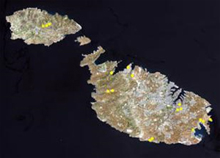Project
Culture change or environmental change?
This archaeological project brings together a range of different disciplines to solve an ancient puzzle, one that questions our notions of the “rise and fall of civilisation”. The project explores how humans in often very restricted places, such as islands, manage to survive and indeed, develop over long periods of time. Human history is punctuated by a succession of changing cultures and distinctive civilisations, each of which emerged specific to a time and place. Invariably, each entity eventually failed to survive in its original cultural or economic form and it was either metamorphosed and adapted to a new set of conditions and constraints, or disappeared completely. We question how particular conditions or circumstances made societies change? We ask how they adapted to change, and how they were sustained when catastrophic events (such as invasion, disease, volcanic eruption or environmental change) disrupted their world? Today, dogmatic environmental determinism is unpopular and sometimes seen as too-decisive an explanation for the enormously complex issues of human change, but nevertheless, at the heart of human existence is its close relationship with the natural environment.

Stress, change and sustainability
The cycle of change and instability imposed on early (as well as modern) human societies by changing environments and resources caused socio-economic stress and cultural and economic responses. Sometimes, change was so profound it led to a society’s extinction. However, human resourcefulness often saw adaptation and evolution of one way of life to another – cultural and technological transformations took place and a different culture emerged – sometime almost unrecognisable from the earlier form. For the archaeologist, it is the cultural expression of stress and change (however we define the difficult notion of culture) that sometimes survives in archaeological form. This can be as ancient economic evidence, artefacts or the physical signals preserved in bones and sediment that inform us about the impact of change on ancient societies. Our expectation might be that this endless cycle of change is well understood, and that theories have been developed to explain the immensely important issue of adaptation towards sustainability in ancient society, but in fact much research is still needed. In this project we bring together key interdisciplinary approaches in environmental science, chronology, archaeology and biological anthropology to explore factors that underpinned the sustainability of a specific European island society. We question whether failure and collapse are an inevitable outcome of issues such as climate change, soil exhaustion, or technological failure, since some cultures developed robust and resilient survival mechanisms that enabled continuity, often in the face of catastrophic change and instability. Understanding better those mechanisms of resilience may resonate with issues in our modern world, as well as the world of prehistory.

Malta and the rise and fall of an early civilisation
We have chosen the small island archipelago of Malta, one of Europe’s earliest civilisations, as our island laboratory for the investigation of a long-held question of cultural continuity and change in the Neolithic five and half thousand years ago. Our archaeo-environmental project examines the development of this small island archipelago in order to develop models of how societies emerged, expanded, were sustained, and then finally declined, collapsed, or got transformed or replaced. Settled c.5300BC, and probably cleared of most of their pristine vegetation within a few centuries, the Maltese islands supported a thriving, substantially populated and remarkably sophisticated civilisation. By c.3000 BC, many extraordinary megalithic temples demonstrated the most precocious complex architecture and culture of the period in all Europe. For 2500 years, this relatively isolated island society maintained a high culture, and their temples appear to have been central to a well organised system of production and redistribution of foods and feasting.
Many key questions about the emergence, maintenance and disappearance of this culture remain unanswered. How was it sustained? Why were the temples built? Did erosion, landscape degradation, environmental instability and over-exploitation combine to bring social stability to an end in the later third millennium BC? What was the origin of the Bronze Age cultures that followed? How did the demography of the islands fluctuate from the Neolithic period, through the Bronze Age until the establishment of Phoenician colonies in the first millennium BC, and how did population structure relate to environmental change?
Our research questions begin at the general level of inquiry
- Why do some cultures manage to sustain their civilisation for centuries or millennia, while others collapse in response to the impact of changing conditions in the wider environment?
- What factors lead to socio-economic decline and failure in a society?
- Can science, by employing a suite of interdisciplinary approaches, begin to explore and understand how humans interacted with, and impacted on, the changing natural environment?